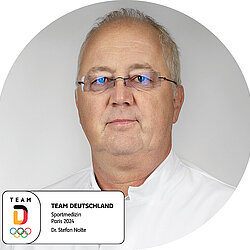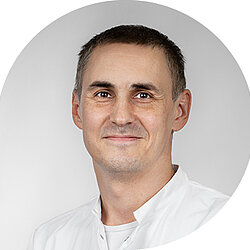In conservative orthopaedics, our specialists are particularly dedicated to the holistic health of the musculoskeletal system and joints without the use of surgical measures.
In addition to targeted therapy for back problems, spinal disorders and pain treatment, we offer a wide range of conservative (i.e. non-surgical) approaches for all orthopaedic challenges. From sports injuries and joint problems to degenerative diseases - we focus on individual diagnosis and targeted therapeutic approaches to improve your quality of life in the long term.
- Conservative treatments for disc-related and degenerative spinal disorders, such as sciatica etc.
- Injection treatments on various structures of the musculoskeletal system, e.g. facet joints, sacroiliac joints, fascia structures, trigger point therapy, so-called sclerotherapy, etc.
- Osteoporosis therapy
- Various physiotherapeutic procedures, osteopathic techniques such as fascia treatments
- Natural healing methods such as leech therapy
- Interventional spinal pain therapy: various peridural injection procedures, PRT, cryodenervation of painful vertebral joints, etc.
- Movement analysis
- Training control
- Manual medicine and chirotherapy
- Physical therapy
- Physiotherapeutic treatments
- Acupuncture
- Proliferation therapy
Sciatic pain / sciatica
Conservative orthopaedics focuses on the non-surgical treatment of sciatic pain caused by irritation or compression of the sciatic nerve. In addition to a thorough diagnosis, our specialists use targeted therapeutic approaches such as injection treatments, physiotherapy and osteopathic techniques to relieve pain and restore function.
Bone loss / osteoporosis
Treatment of bone loss (osteoporosis) using a holistic approach. In addition to drug therapy approaches, various physiotherapeutic procedures, osteopathic techniques and special measures to strengthen the bone structure are used. Individual diagnosis and advice are the focus of osteoporosis-related treatment.
Interventional spinal therapy (cryodenervation)
The joint capsules of the vertebral joints are densely permeated with pain fibers. These so-called facet joint nerves transmit pain signals centrally, which often leads to chronic back pain. The aim of cryotherapy is to specifically switch off these pain fibers and thus interrupt the transmission of the joint capsule pain. This special form of cryotherapy (from the Greek word "kryos", meaning frost) is mainly used for chronic back pain. This pain can sometimes radiate into the arms or legs and often affects patients with proven signs of wear and tear on the spine.
Conservative pain treatment
Conservative pain management in conservative orthopaedics focuses on relieving pain without surgical intervention. Our specialists use a variety of conservative therapy approaches, including injection treatments, physiotherapy, osteopathic techniques and naturopathic procedures, to address your individual needs and body.
Nutritional medicine
In conservative orthopaedics, our specialists not only look at the structural aspects of the musculoskeletal system, but also the importance of nutrition for holistic health. A balanced diet plays a decisive role in the prevention and treatment of orthopaedic complaints. Our specialists integrate nutritional approaches into the overall treatment to promote a holistic recovery.
Naturopathy
Our specialists use natural healing methods as a complementary therapy option. In addition to conventional approaches, we use methods such as leech therapy to activate the body's self-healing powers. The use of naturopathic methods always takes into account the individual needs and complaints of each patient.
Sports medicine
Conservative orthopaedics also refers to sports medicine, with our specialists specializing in non-surgical approaches to treating sports injuries and orthopaedic problems associated with sporting activities. In addition to special injection therapies and physiotherapeutic measures, we emphasize preventive approaches to promote athletic performance and prevent injuries.
Spinal therapy
In conservative orthopaedics, our specialists are dedicated to the non-surgical treatment of your complaints and pain in the area of the back and spine. Our range of services extends from classic herniated discs (lumbar disc herniation in the lumbar spine and cervical disc herniation in the cervical spine), lumbago and sciatic pain to spinal stenosis, problems in the cervical spine, thoracic spine, lumbar spine and scoliosis.
Our back specialists use special injection therapies, osteopathic techniques and pain medicine procedures to relieve your pain and restore your back health. Each treatment is preceded by a detailed diagnosis and consultation.

Claudia Schnitzler-Moos
Secretariat Conservative Orthopedics
- Phone+49 2351 945-2249
- Fax+49 2351 945-2253
- sekretariat.nolte@hellersen.de



